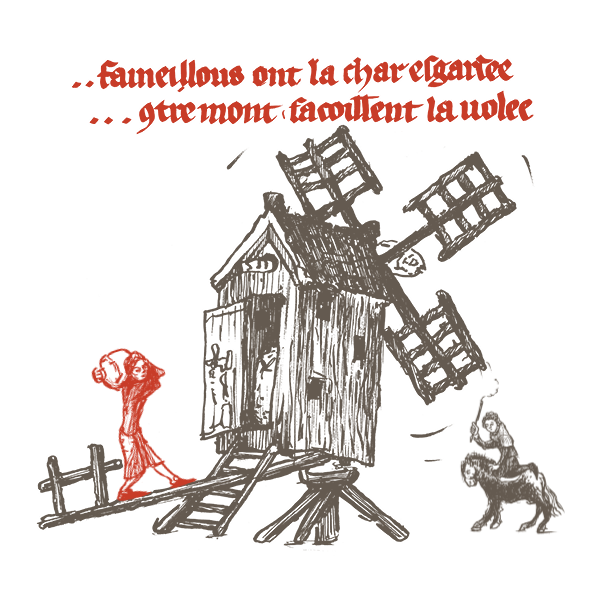Old French refers to the language spoken and written in parts of what is now France from the 9th to the 14th century. It evolved from Latin and underwent significant changes during this period.
Language
Old French encompasses all the Romance languages of the langue d'oïl family spoken approximately in the northern half of present-day France, in the south of present-day Belgium, and in the Jura mountains in Switzerland. The rest of the territory spoke a kind of Provençal French between the 8th and 14th centuries. Old French is therefore the ancestor of the French spoken today and, more generally, of all the Oïl languages spoken today (Gallo, Lorraine, Normandy, Picardy, etc.). The spread of French came relatively late; for example, around the time of the French Revolution, it is estimated that three-quarters of the French population spoke a dialect rather than French.
Old French was derived from Romance and several dialects of Vulgar Latin found throughout the Roman world. French was also heavily influenced by several ancient varieties of Oïl. Overall, French evolved gradually from Latin into Romance and then into French.
The history of the French language begins with the invasion of Gaul by the Roman armies under Julius Caesar in the 1st century. After the conquest of Gaul, Roman soldiers and merchants brought with them the sermo cotidianus or Vulgar Latin. Latin functioned as the language of writing and administration, while Gaulish was spoken. So, let's take a look at Latin and Gallic.
Vulgar Latin
It differs from classical Latin in that the language uses derivatives, for example with the term manducare, meaning to chew, which is used more than edere to mean to eat. There were 6 declensions in Classical Latin, but only two remain in Vulgar Latin (the nominative and the accusative).
Vulgar Latin saw the appearance of analytical verb forms, with the future tense, passive forms, and the perfect tense.
In this language, word order tended to become increasingly fixed, thanks to the use of the accusative and nominative only. Phonetically, there were also some disappearances, such as the final “m”, which is tending to disappear, as in the rosa/rosam declension.
There was also an enrichment of phonemes (vowels, sounds and consonants). This was due to transforming vowel types from Classical Latin to Vulgar Latin. Some vowels became short, some become long (é became è), and others, such as o, became closed. As a result, some short vowels disappear, for example calidus, which becomes caldus and today means hot, or “chaud” in french. Sounds such as v and z also appeared.
Gaulish
When Roman rule was first established, Gaul was populated by a multitude of Gallic tribes who spoke Gallic. As a result, there were many regional varieties of Gallic. After the conquest of the country in 51 BC, and over the following centuries, the language of the Romans (Vulgar Latin), or at least their terminology, was gradually adopted by everyone, but bilingualism remained a reality until around the end of the fourth century. Romanesque vocabulary had a major influence on Old French.
The influence of the Gallic language on the phonetic development of Gaulish Latin is harder to determine. But it is very much present, as we can see from the evolution of “pt” and “ps”, which merged with “kt” and “ks” and were reduced to “xt” and “xs” and then to it and is. For example, captivus gave way to kaxtivus to give chaitif in Old French and today means chétif in French.
This is a language with declensions of conjugations, with a very rich lexicon of derivations and compositions (suffixes and prefixes). However, this language remains little known, even though it is being studied more and more.
Galloroman
The centuries from the end of antiquity to the beginning of the Middle Ages are essential for understanding the genesis of the French language that developed over this long period. The migrations of the Germanic peoples from the Lower Empire were partly responsible for the fall of the Roman Empire in 476, and traditionally mark the end of phonetic developments common to the whole of Romania. Thanks to this period, we can see the Germanic and Celtic influence that separated the langue d'oïl from the langue d'oc. However, some words of Germanic origin entered French later, such as the word "boulevard", which comes from Neerlendais, from bolwerc.
The influence of Germanic languages on the Vulgar Latin spoken in northern Gaul also had phonetic consequences, with the appearance of new phonemes that were either non-existent (particularly in the vowel system; e, eu, u, o open) or had disappeared from Vulgar Latin. For example, “w” appeared with the borrowings from Germanic languages. During this period, the tonic accents of middle intensity were strengthened.
Germanic syntax likely influenced the formation of French. In terms of syntax, the systematic presence of a subject pronoun before the verb is comparable to that of Germanic languages, for example.
The Strasbourg Oaths written in 842 are often regarded as the "birth certificate of the French language":
Pro deo amur et pro christian poblo et nostro commun saluament, dist di in auant, in quant deus sauir et podir me dunat, si saluarai eo cist meon fradre Karlo et in aiudha et in cadhuna cosa, si cum om per dreit son fradra saluar dist, in o quid il mi altresi fazet, et ab Ludher nul plaid nunquam prindrai, qui meon uol cist meon fradre Karle in damno sit.
This language is very detached from its Latin mother tongue: some of its phonetic and syntactic features are common to the Romance languages under construction, while others are ancestors of Old French. The Latin influence can be seen in the syntax. In the position of a noun expanding a noun: Pro deo amur, while the Germanic influence is likely to be seen in the position of the adjective before the noun: christian poblo and spelling: presence of k (Karle, "Charles") and dh (aiudha >in Old French aïe "help"; cadhuna in Old French chaün, cheün "each") which transcribes the interdental d (the English sound th).
Old French
French, mainly in its Norman form, was introduced into England in the wake of William the Conqueror's conquest of that country in 1066. It gave rise to Anglo-Norman, a dialect of Oïl, very close to Old French and which did not die out until the 14th century, leaving a deep imprint on the vocabulary of English, particularly in the vocabulary and resulting, in some cases, in the systematic replacement of the term Old English by its Romance equivalent. For example, Old English earm "poor" (German arm) is different
from the Englishword “poor”, borrowed from Anglo-Norman pore (Norman paur, dialectal pour). It is important to distinguish between the Oïl languages, which were opposed to Oc languages (langue d’oc) or called Provençal. Provençal developed in Upper Burgundy, sharing French and Provençal characteristics. Provençal was distinguished from langue d'oïl as early as the 9th century.
The Florentine scholar Brunetto Latini wrote his Livre du Trésor (The book of Treasure) in the langue d'oïl around 1265, explaining that this was the "most delectable and common language for all people". At the end of the 13th century, the Venetian chronicler M. da Canale asserted that "the French language runs the length and breadth of the world ". The French language spread rapidly across the globe. To establish itself, Old French drew heavily on foreign languages. With Arabic, for example, around 270 words are of Arabic origin. Most of them entered the French language via medieval Latin, mainly for scientific words and medicine. For example, nuque (in Latin nuc(h)a). The development of trade by the great Italian cities with Arabic-speaking countries also enriched the language, such as the word cotton, which comes from the Italian cotone, or shop, which comes from the Italian magazzino.
Middle French
Between the 14th and 17th centuries, the French language differentiated itself from regional languages and Latin, and became the official language of the kingdom of France. Indeed, after the Hundred Years' War (1337-1453), vast military operations and territorial conquests had spread "francoys" throughout France and all classes of society. It also brought out a strong French nationalism in the face of the many territories conquered by England. The spread of “Francoys” was all the more important at this time, as the English court also spoke this language. What's more, in 1490, Charles VIII issued a decree imposing the use of "francoys" as a mother tongue. This was also the period of the creation of the first universities, such as La Sorbonne, recognized by King Philippe Auguste in 1200, accompanied by a general secularization of culture and education. This generalization of the French language and the secularization of France enabled the French language to gradually distance itself from Latin and regional languages. The meaning and usage of a large number of Old French words were transformed. Spelling and punctuation were highly unstable during this period, which eventually led to the need for reform, particularly after the advent of printing around 1470. However, Latin was still used by the elite in education, administration, and bureaucracy until the Ordinance of Villers-Cotterêts in 1539, which made French the sole legal language of the kingdom. Finally, this long period of political, social and economic instability favored a movement of "linguistic loosening", and the whole system of
Script
Each word did not have a fixed spelling and from region to region this spelling evolved, so the same word was written in several different ways. The scribes wrote down everything they heard as directly as possible, using the Latin alphabet. But the Latin alphabet was not rich enough, so when the alphabet evolved it gave rise to new sounds and new letters. Upper- and lower-case letters began to appear in the 14th century. Punctuation did not appear until the 12th century. But the uses of punctuation are very different. What's more, it's complicated to understand manuscripts because they are written in 2 or 3 families of Latin alphabet in which there are many variants. These characters are beginning to break away from the Latin alphabet, while at the same time drawing inspiration from it. For example, these alphabets did not distinguish between i and j, which did not have a dot at the top, and i did not have a dot but had an apex to make it easier to distinguish (a sort of accent on i). At the beginning of the 15th century, the Humanists sought to create more legible models and lighten the Gothic script, which was sometimes too busy. They used the Humanist lowercase, italics, etc. The Old French alphabet is not so different from the alphabet used today.
Several spelling usages in Old French involve diagrams. A diagram is an assembly of 2 uncounted diacritical signs that form a single grapheme. This diagram can only be read if the meaning of the 2 signs is taken separately, and it then represents a phenomenon or a series of phenomena. The desire to respect Latin usage and the etymological origin of words explains the difficulty of using the French language. Generally, this difficulty arises from the fact that the same Latin letter, which originally described a single phenomenon, has come to denote several phenomena. It is important to consider the variation in spelling, which varied from region to region.

Literature
Old French literature
- 9th century: Séquence de sainte Eulalie about 880
- 10th century: La vie de Saint Léger (The life of Saint Léger) about 980
- 11th century: Vie de Saint Alexis (Life of Saint Alexis) about 1040
- 12th century: Chanson de Roland (Roland’s song) about 1170
- 12th century: Alexandre de Bernay who wrote le Roman d’Alexandre (The novel of Alexandre) about 1185
From the beginning of the 12th century, courtly literature flourished, including lyrical poems and “lais” sung by jugglers. A “lais” is a French word without English translation, it means a kind of poem. Most of this literature was anonymous. The name of Marie de France is associated with most of the lais composed between 1160 and 1178. The “chanson de geste” (song of gesture) is a European literary genre of the Middle Ages. It is a verse narrative in decasyllabic and later in alexandrine and uses the literary technique of the epic.
Chrétien de Troyes (born around 1130 and died between 1180 and 1190) was a French poet, considered to be the founder of Arthurian literature in Old French and one of the first authors of romances of chivalry. He served at the court of Champagne during the reign of Henry the Liberal and his wife Marie de France. His major works include Érec et Énide, Cligès, Lancelot ou le Chevalier de la charrette, probably written at the same time as Yvain ou le Chevalier au lion, and the unfinished Perceval ou le Conte du Graal. His novels reflect the political and cultural ideals of the milieu for and in which he wrote. They portray an aristocratic ideal combining chivalric adventure, courtly love and the religious aspirations symbolized by the crusading spirit.
La chanson de Roland: The Roland’s song is an epic poem from the 12th century. The Chanson de Roland consists of four thousand and two verses (in its earliest version; there are nine thousand in a manuscript from the end of the 13th century) in Old French, divided into assonance, transmitted, and sung by troubadours and jugglers. It was inspired, three centuries later, by the fatal battle in the Pyrenees of the knight Roland, prefect of the March of Brittany, and his comrades-in-arms against a force still difficult to identify, possibly the Basques.
Middle French literature
The French language was particularly marked by François Villon's (1431-1463) expressive use of Middle French. Villon's impact on Middle French lay mainly in his ability to innovate linguistically, introducing new turns of phrase and everyday expressions into his poems, thus broadening the lexicon and syntax of the language of the time and making it accessible to the widest possible audience. In his most famous work, "le Testament", written in 1461, Villon also introduces an autobiographical dimension, creating a more direct link between author and reader.
The Middle French period was also marked by the influence of women such as Christine de Pizan (1364-1430). Christine de Pizan played a crucial role in linguistic evolution, using language as a means of defending women's rights, in accessible French that helped expand the Middle French lexicon. She shaped linguistic discourse around the female condition.
Influence
Old and Middle French have largely influenced the construction of modern French. In its day, Old French was spoken in the north of the Kingdom of France, and the Norman dialect spread to England and Ireland. During the crusades, Old French was also spoken in the Kingdom of Sicily, and in the Principality of Antioch and the Kingdom of Jerusalem in the Levant. It was a very popular language at its time.






